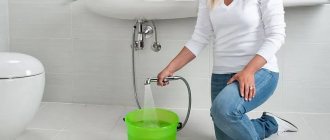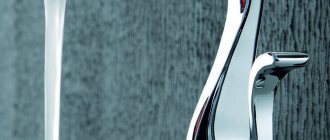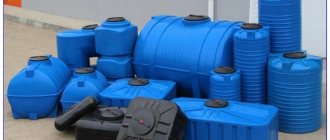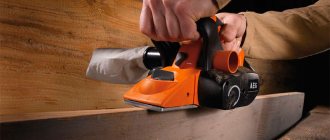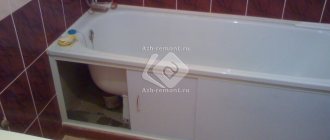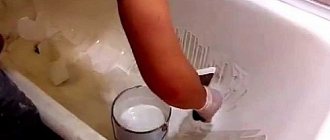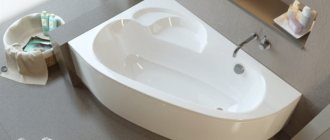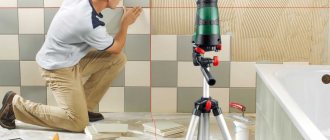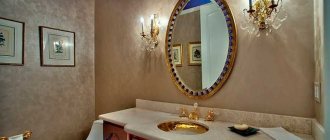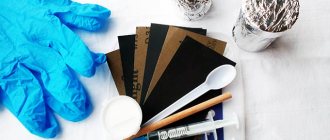It’s easy to apply, inexpensive, and masks surface defects well—it’s not for nothing that self-leveling acrylic for bathtubs is so popular. You can carry out restoration work yourself and without the use of special tools. After hardening, the mixture is characterized by high strength and durability.
We'll cover how to find the best polymer blend. We'll tell you which market offer will be most suitable. Let's look at the assortment and see what parameters you need to pay attention to when choosing this material.
What is acrylic mixture
The technology for resurfacing plumbing fixtures appeared about 20 years ago. For this, liquid acrylic is used, which is applied to the plumbing fixtures and left for some time to harden. The result is a shiny and smooth coating that is highly durable and resistant to damage. This product can be used for both steel and plastic bathtubs. You can also coat cast iron products with acrylic. The surface layer has a long service life and perfectly hides minor defects.
Applying acrylic to a bathtub Source vitrum-novo.ru
The following brands are represented in Russia:
Rice. 1. Popular brands of acrylic
Rice. 2. Little-known brands
Rice. 3. Foreign self-leveling acrylic
Popular:
- Plastall (correctly read - plastol, incorrectly - plastal). It is produced in Togliatti by Plastol LLC under the control of the Pabrec DOO concern (Slovenia). Product line: plastol premium 24, plastol-M, plastol classic, plastol titanium, plastol super 16.
- Ecovanna. Produced in Moscow by Ekovanna LLC. Product line: liquid acrylic Lux, antimicrobial acrylic with silver ions, black acrylic Shungite.
- YarLi. Yaroslavl plant of paints and varnishes, Yaroslavl. Products: self-leveling acrylic YarliSoat 616.
- Glasscryl. Manufacturer LLC Ekolor, St. Petersburg. Product line: Stakryl, Stakryl Profi.
Little known:
- Plastvanna
- Ecoacrylic
- Finacryl
Foreign:
- Ecopel is produced by the same concern Pabrec DOO, which controls the production of plastol in Russia. It is used for the restoration of bathtubs using the pouring method in the European Union and the USA.
Fakes
You can read more about fakes of liquid acrylic here.
If you want to learn even more, read the most detailed review of liquid acrylics for bathtub restoration on the Internet.
Advantages and disadvantages
Self-leveling acrylic has many positive characteristics:
- The surface retains its temperature for a long time;
- There is no slipping;
- The coating is pleasant to touch;
- It is possible to color the mixture before application;
- The acrylic layer lasts a long time and resists wear well;
- The surface is resistant to constant loads;
- Whiteness lasts for a long time, it is easy to maintain the shade;
- Easy product care;
- Safety for health and the environment;
- Possibility of using chemicals;
- Long-term preservation of initial characteristics;
- Protects plumbing fixtures from the proliferation of pathogenic microorganisms and also prevents the formation of fungus;
- Possibility to repeat application of acrylic depending on need.
Bath before and after restoration Source beristroy.ru
In addition to its advantages, the product also has some disadvantages:
- It takes a long time to dry, this process can occur over several days;
- The likelihood of dust and debris sticking, which can affect the final result;
- Do not use aggressive chemicals or abrasive substances to care for the surface.
Restoring the bathtub cover Source gidpokraske.ru
Comparison
We decided to analyze information on the three most popular types of liquid acrylic and answer several questions at once, which is better:
- stakryl or liquid acrylic luxury?
- stakryl or plastol?
- plastol or ecovanna?
To do this, we will analyze consumer reviews and our own practical experience.
What people say:
the ratio of the number of negative reviews to the total number of reviews containing an indication of the acrylic brand.
According to information from the review site irrecomended.ru stakryl – 24% plastol – 18% Ecovanna – 11%
According to reviews on the website otzovik.ru eco-woven – 19% plastol – 4% stakryl – 12%
Taking into account the statistics of these sites, it is worth making allowances for the fact that (according to research by the international marketing company Nielsen) people are more willing to write negative reviews, and if everything is in order, they remain silent. It is worth understanding that negative reviews in this case are caused not by the properties of the material, but by the work of the master - that is, the final result, which does not depend on the characteristics of acrylic. This may well mean that an unscrupulous company is working with good material. Therefore, below we present our own practical data.
What practice shows:
To obtain more reliable statistics, we counted the number of justified warranty claims over 8 years of work that were not related to the technician’s errors (sample of 20,254 clients*).
Number of warranty claims:
- stacryl – 0.7%
- plastol – 0.3%
- ecovanna – 0.5%
*The data given is subjective and is not a reliable basis for determining the quality of the material.
Types and manufacturers
There are a large number of products on the market that differ in their properties and composition. Manufacturers include various ingredients in their products that affect the color of the coating and its method of application. Typically, an acrylic mixture consists of a base and a hardener, which are mixed before use. The instructions also indicate exactly how to prepare the solution, as well as how to apply it to the plumbing.
Acrylic bathtub surface Source stroy-podskazka.ru
The following types of acrylic are most widespread among users:
- Glasscryl. This is the very first product created to restore the surface of bathtubs and other plumbing fixtures. It has a heterogeneous consistency and a special structure that does not respond well to the use of solvents. The mixture comes in a white shade, but it is possible to add another color in the form of a special tint. This type of acrylic is very reliable, it can withstand significant loads without damage. The service life of the surface is several years. Among the disadvantages of the product are not very convenient application, as well as long drying and unpleasant odors during operation.
Acrylic mixture Stacryl Source stacril.com.ua
Preparing plumbing for restoration
To ensure the most predictable result, the bathtub is specially prepared for restoration work. To do this, you need to complete the following steps:
- Prepare the necessary materials. You will need to find sandpaper, a brush, a cleaning agent such as baking soda, and a putty knife with gloves.
- The drain hole and overflow are cleaned and the linings are removed from them.
- Plumbing equipment is treated with sandpaper and thoroughly degreased.
- All damage is well puttied.
- Repeated cleaning and washing.
Before applying acrylic, the bath is heated with hot water for several minutes. After this, the liquid should be removed and the surface to be treated should be thoroughly dried with a hairdryer.
Required Tools
Before you go for the liquid acrylic itself, you will need to inspect your supplies for the rest of what you need. In this way, you will be able to avoid a second visit to the store by purchasing everything on the list in one go.
The toolkit will include:
- sandpaper/sander/drill with a sanding disc with appropriate pads. The sandpaper must be on a waterproof fabric fastener. With its help, the old coating will be cleaned. You will need at least 5 sheets. For cast iron, steel and secondary restoration of any bath – grades P60, P40. For acrylic – P80, P100. Secondary restoration is recommended to be carried out only with the help of equipment, since a thicker layer will have to be removed;
- degreaser. Solvents such as White Spirit (647), 646 and any similar products are suitable. Some people opt for soda, but this is not a very good option for ensuring good adhesion of the surface to the composition;
- a screwdriver or screwdrivers with a straight and Phillips end, a low basin and rags. Will be needed to remove the drain;
- covering film, masking or fastening tape. To protect walls, taps and floors. The width of the tape is from 5 cm or more;
- clean spatula 10-15 cm wide. Plastic or rubber with a comfortable handle for applying the solution;
- spatula or construction mixer for mixing the solution. A wooden stick or a narrow plastic spatula about 40 cm long is enough. But some people like to use a mixer or a mixer attachment on a hammer drill;
- bath putty;
- flashlight.
You will also need a knife or scissors on hand to cut the tape. It is convenient to have a stool or chair nearby. The work is carried out at a low height from the floor, so bending down each time or picking it up from a chair is a personal choice of convenience for everyone. It’s a good idea to stock up on a hair dryer to blow away dust and speed up the drying of the bowl after washing.
Be sure to have protective equipment: overalls or a jacket with long arms complete with trousers, rubber gloves, a respirator, goggles.
All this will protect a person from an aggressive solution. It is highly advisable to wear a headdress to prevent hair from getting onto the surface during processing.
How to apply liquid acrylic to a bathtub
The method of application depends on the composition of the mixture; it may differ for each manufacturer. To avoid mistakes, always carefully read the instructions before use. General rules imply this coating method:
- Preparation of the mixture. The material should be slightly warm for quick reconstitution. The base is poured into the container, and then the hardener is added to it. The resulting mixture must be thoroughly stirred for 10 minutes until the consistency becomes completely homogeneous. This process must be performed very carefully, without splashing the liquid around. It is best to use a regular stick for this purpose. Then the mixture should sit for several minutes. Don't leave it for long as it will harden completely within an hour.
- If desired, you can add color to obtain the desired coating color. It is advisable to use a product from the same manufacturer as the mixture itself. This will ensure perfect compatibility when mixed. Otherwise, delamination of the material may begin, which will become unsuitable for use.
- Cleaning and preparing plumbing fixtures. The surface must be thoroughly dried, and a container must be placed under the drain to drain the material. The tiles and flooring should be well protected from the solution.
- Application of material. The mixture begins to cover the surface from the edges, evenly pouring over the walls of the bath. Once the acrylic gets into the middle part of the plumbing, the process is repeated with the next layer.
- After application, the device must be left to allow the material to harden. The room is closed and people try not to visit it to prevent the penetration of dust and small debris. Even an accidentally falling hair can ruin the entire work, so it is necessary to provide protection to the applied layer.
- When polymerization is complete, all that remains is to remove excess material near the drain hole and secure the strapping.
It is important to remember that after application you should not touch the surface, try to reapply the product or correct flaws. Otherwise, the coating may become uneven and the work will be ruined.
What's the deal with enamel paints?
Enamel for painting bathtubs with a brush or roller is not counterfeited, because the demand for it is low, and with the advent of self-leveling bathtubs it is becoming less and less available - it is simply not profitable. But those who like to save money have found a way out here too - they paint the bathtub with paint that is not intended for contact with water and, most importantly, for contact with the body. They don’t even disdain alkyd or nitro paints. Taking such a bath is dangerous - alkyd and nitro paints emit carcinogenic substances and can cause cancer.
Check the material that the master brings to order or that you purchase for DIY work, ask for certificates. If you see a discrepancy, it is better to refuse to perform the work.
